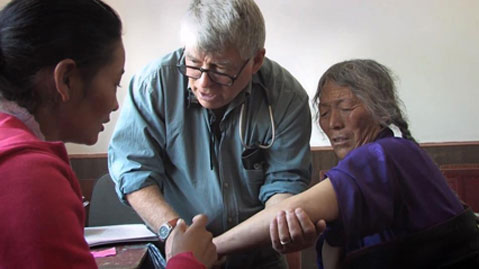High Plains Doctor
Director Michael Dayan

On the surface, Michael Dayan’s film High Plains Doctor is the story of Dr. Isaac Sobol’s 10th and final year running a volunteer health clinic in the Yushu region of Tibet, a remote and culturally important part of the country that has since been all but erased by a devastating earthquake. But more than that, the film is a compelling mediation on what modernity means for indigenous people the world over and how this disenfranchisement can wreck havoc on general public health.
How did you come across the story that is this film?
The story came to me through my good friend and collaborator, Dr. Roman Elinson. Roman had previously volunteered with Dr. Sobol and when I saw his photographs and heard his stories, I began to visualize the early stages of the film. I spoke with Isaac over the telephone to be sure there was enough rapport between us, but I had never met him before getting on the plane [to TIbet] at the Vancouver airport. I took a leap of faith; it was the first of many required to make this film.
Tell me a bit about the idea of, what Sobol calls, indigenous peoples’ “loss of culture, language, and landscape” and how that helped shape your storytelling.
Sobol is an expert in aboriginal people’s health. At the time of the shooting, he was Chief Medical Officer of Nunavut. That’s the massive territory spanning across much of Northern Canada, right up to the Arctic Circle. The film documents Sobol on his final medical mission in Tibet. As such, it deals with certain aspects of public health that aren’t usually front and center.
To some, the forces of modernity are all positive. To others, these same forces bring rapid change in the form of displacement and disenfranchisement, loss of traditional ways of working and experiencing culture, and loss of language and knowledge. The film shows how with loss of culture, language, and landscape, people are prone to depression, malnourishment, and marginalization. This is what I’ve seen in Canada and Tibet and I’ll bet it applies to the American context as well. Throughout his younger life, Sobol felt himself an outsider; in Northern Canada and Tibet he finds belonging and connection by embracing people whose own sense of belonging and connection is threatened.
How hard was it to work with China’s authorities and to keep politics mostly out of the film?
For so many, the words “Tibet” and “politics” are synonymous. Likewise, public health — because it deals with the impact of environment, culture, and lifestyle on wellbeing — may become politicized. I didn’t want to make this film just another political polemic. I don’t know enough about the history and politics to make that kind of critique and that simply is not my filmmaking mandate.
My objective with this film was to document a redemptive story of an individual who struggles with his own depression and personal feelings of displacement by investing his full energy into demonstrating that he cares for others and showing them that they are not alone. Of course, while shooting, I met with my share of highly curious security guards and plainclothed characters who needled me with questions, but I was cautious and discrete and ultimately there was no problem.
For you, as the filmmaker, what were the biggest triumphs and heartbreaks you encountered during filming?
It was so hard to be surrounded by so much despair and to feel so limited in my capacity to ease others’ suffering. This hardship was offset by the joy reflected in the children’s faces and the natural and cultural beauty I experienced everyday: taking in the fresh air and the calm, living a full month without one telephone call or email, and climbing atop the Yushu monastery to catch a sunrise. I enjoyed a seamless connection with people despite clear language barriers. And I learned that, while Dr. Sobol and his team gave tirelessly they also received. I observed that true gifts go both ways.
As you know it, what is the current state of things in the Yushu region post-earthquake?
My access to information has been severely limited. But from what I’ve been able to gather, Yushu now stands as piles of rubble, resulting from an earthquake registering at 7.1 at an epicenter only 30 km away. I know Dr. Sobol has tried, unsuccessfully, to return, but High Plains Doctor documents his final medical mission to Yushu.
Tragically, the film may also be a final testament to a lost way of life in a town unlikely to be rebuilt with its traditional character and might otherwise only live in the memories of a few.
What is Dr. Sobol up to these days?
Dr. Sobol is now living in Vancouver, where he directs public health for the First Nations communities of British Columbia and the Yukon. He and Dr. Elinson will be joining me for the first two screenings on the SBIFF opening weekend. I’m grateful to them both and I’m excited for what I imagine will be two fun and engaging Q&As.
High Plains Doctor screens on Fri., Jan. 25, 10 a.m., and Sun., Jan. 27, 4:20 p.m., both at the Metro 4. See helliwellpictures.com.



